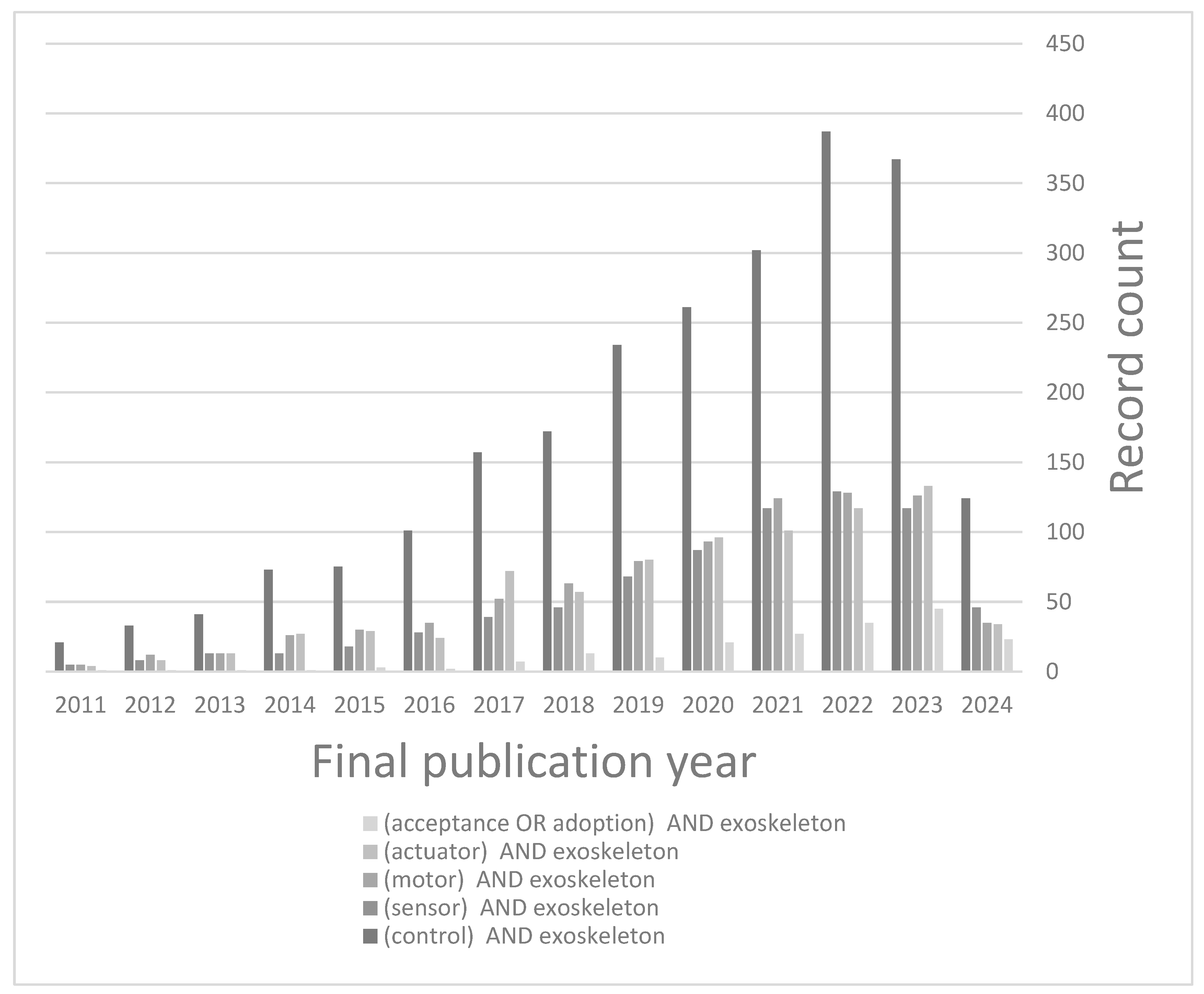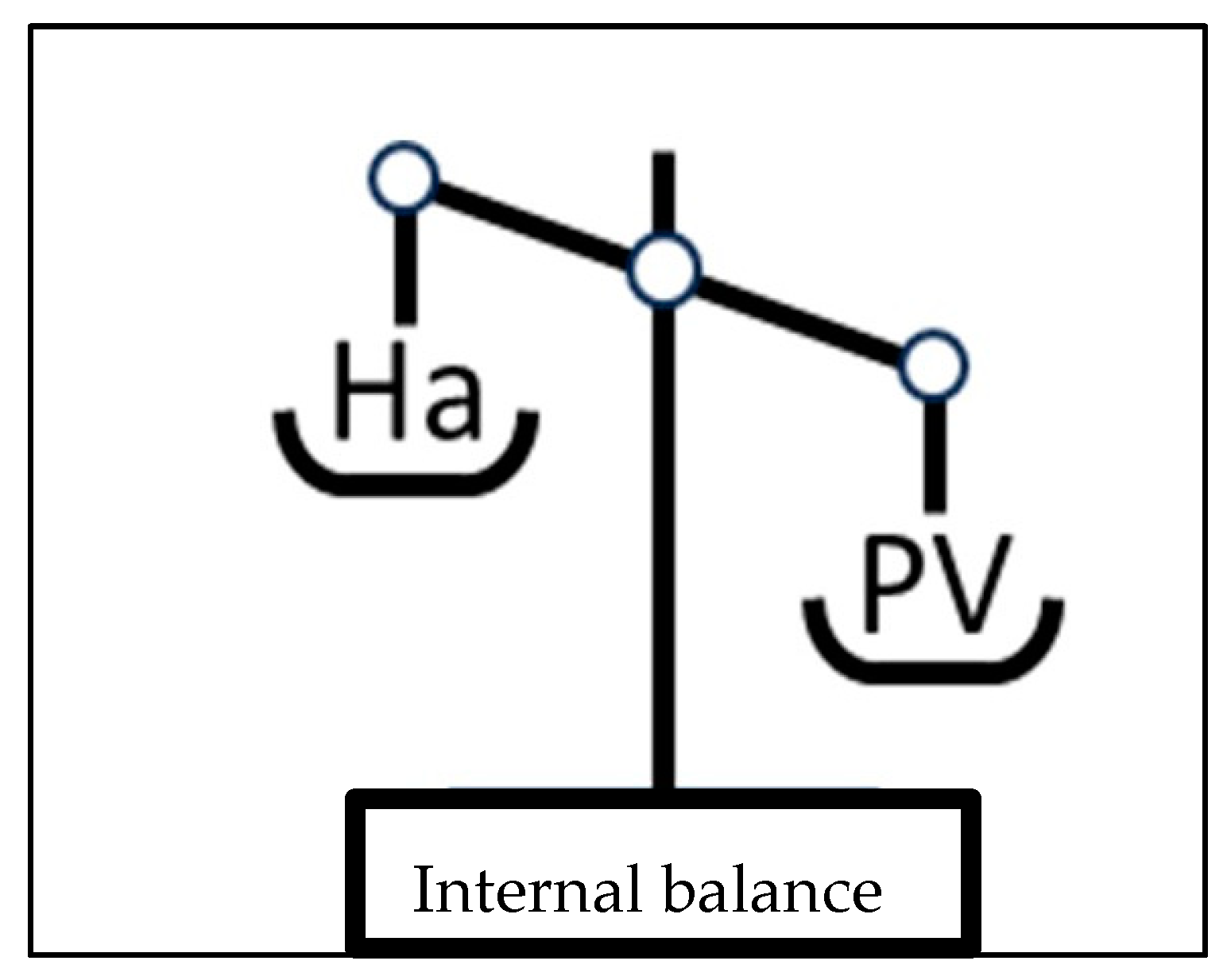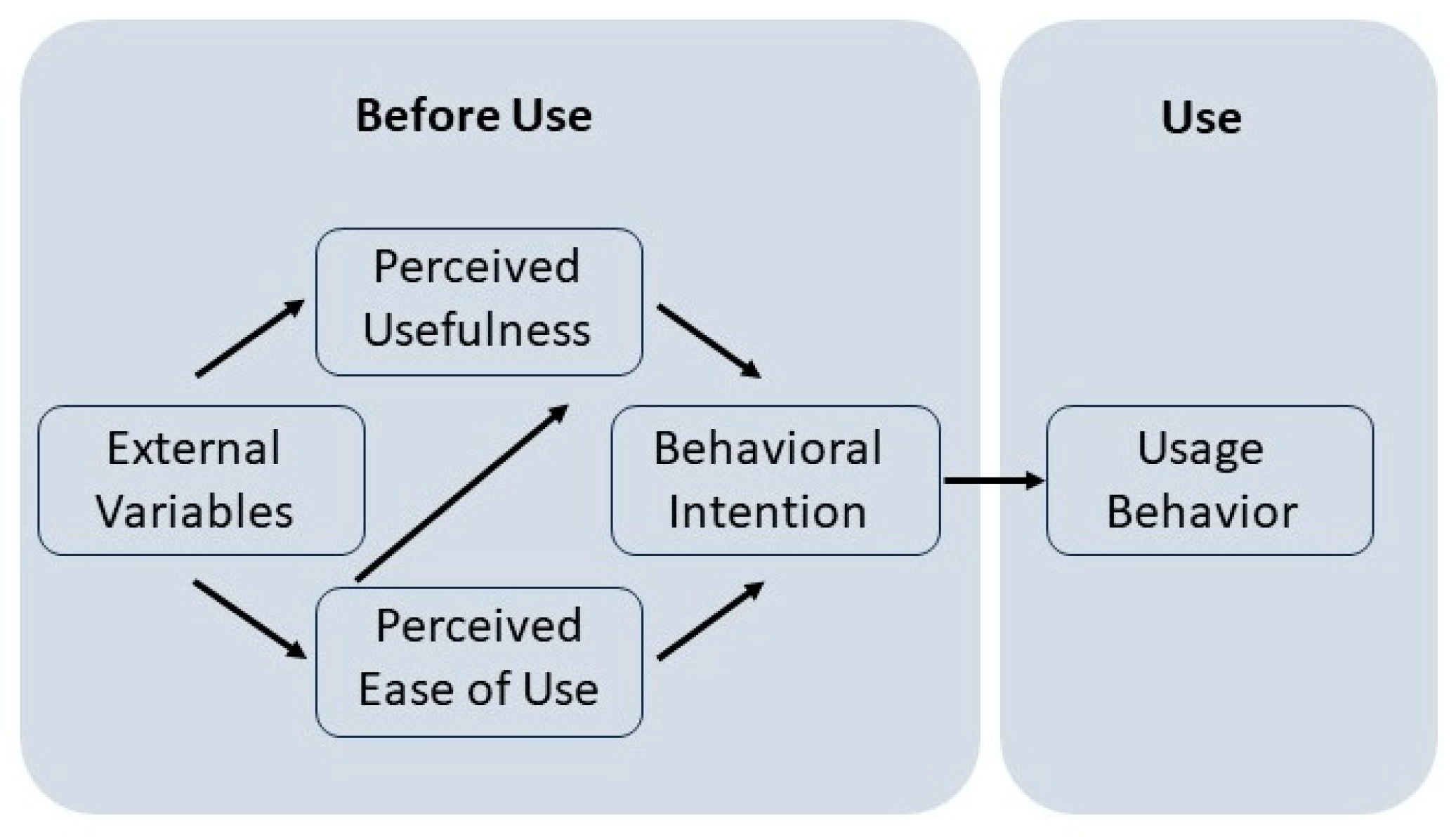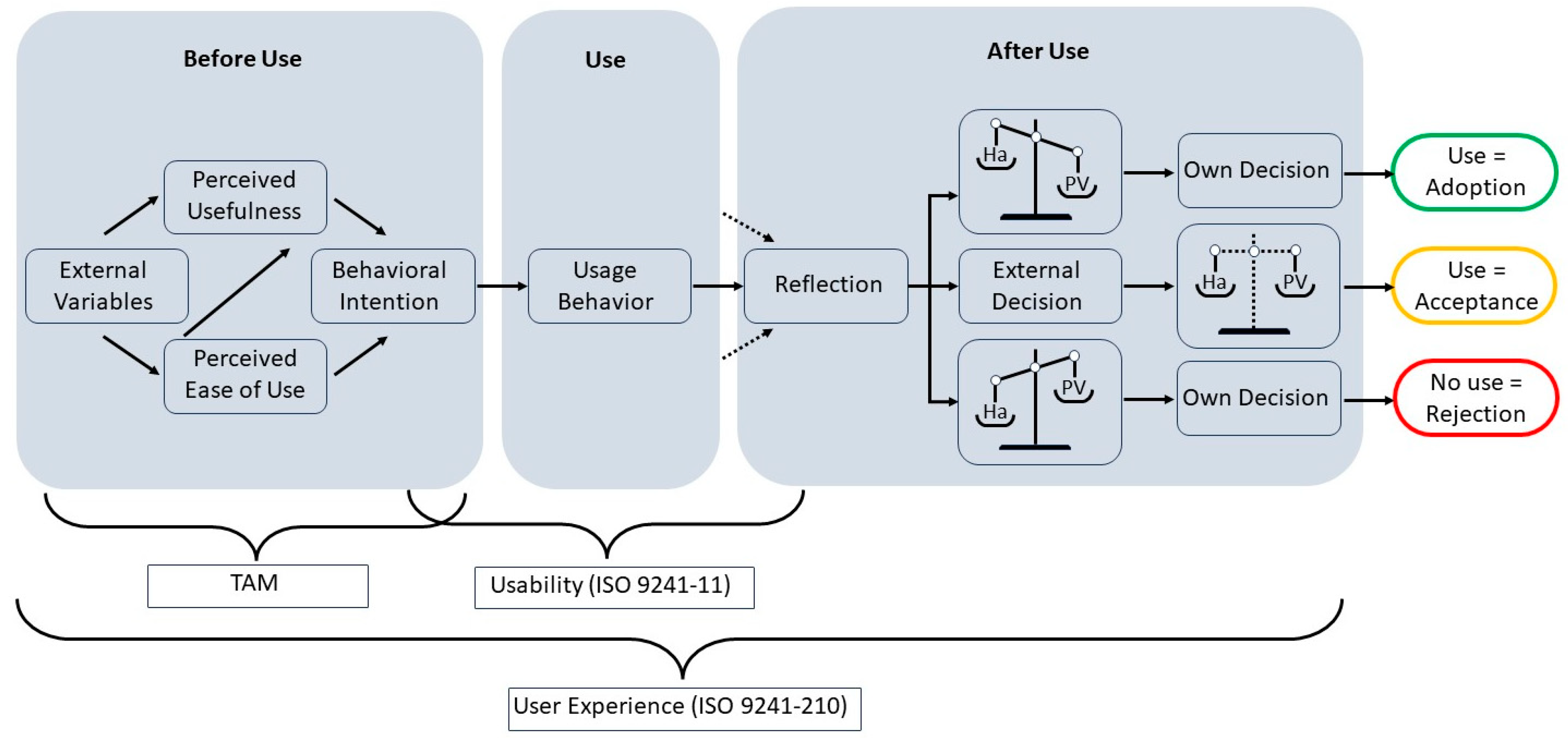Assessment of Exoskeletons for Work Activities: The Dilemma behind the Product
Abstract
:1. Introduction
2. Background
3. Materials and Methods
3.1. Method of Development
- Filtering term: “(development AND (process OR method)) AND exoskelet*”. These terms are central to this research. Given our focus on achieving the process of exoskeleton development, they were specifically chosen for this study. “Process” and “method” are often used interchangeably as synonyms and are therefore explored together in this context.
- We limit the topic to focusing on the product itself. We are now looking at the following topics:
- ○
- Engineering.
- ○
- Rehabilitation.
- ○
- Computer science.
- ○
- Neurosciences neurology.
- ○
- Robotics.
- ○
- Behavioral sciences.
- ○
- Social sciences.
- ○
- Health professions.
- ○
- Multidisciplinary.
- ○
- Psychology.
- Filtering is performed by focusing on keywords found in the title.
- Filtering of publications older than 2020 was not considered (to ensure the timeliness of this article).
- Filtering only articles.
- Double-checking via the software Mendeley Desktop 1.19.8.
- Filtering content based solely on the title.
- Filtering is conducted based on the abstract content.
- Finally, 44 articles were read in depth. In the end, we used only a total of two articles for this study because none of the others demonstrated a process behind their development. This raises the question of how exoskeletons are typically developed and whether a formal method (as known in the discipline of product development) is used.
- The objective of this work is not to deliver an exhaustive overview of the literature but to offer valuable insights and highlight the most relevant publications. The research indicates that most of the articles found in this research concentrate on the technical development of specific components, functions, or software aspects of exoskeletons. In contrast, only a limited number of studies address the holistic development of systems intended for practical, real-world applications.
| Web of Science | Scopus | IEEE | |
|---|---|---|---|
| Filtering term: “(development AND (process OR method)) AND exoskelet*” | 6454 | 51374 | 4527 |
| Filtering by the topics: | 3994 | 35817 | 4527 |
| Filtering based on the keyword in the title | 270 | 684 | 66 |
| Filtering publications not older than 2020 | 138 | 334 | 40 |
| Filtering article only | 138 | 180 | 33 |
| Double-checking via the software Mendeley | 136 | 176 | 15 |
| Filtering based on the title | 26 | 32 | 2 |
| Filtering based on the abstract | 12 | 29 | 2 |
3.2. Evaluation of Exoskeletons
| Web of Science | Scopus | IEEE | |
| Exoskelet* and (acceptance OR adoption OR evaluation OR assessment) | 1497 | 2907 | 1073 |
| Filtering by topics | 1111 | 2216 | 1073 |
| Include in title | 205 | 447 | 187 |
| Limited to 2020 | 148 | 298 | 104 |
| Article | 136 | 176 | 33 |
| Doppelcheck via Mendeley | 123 | 143 | 33 |
| Filter by title | 24 | 32 | 5 |
| Filter by abstract | 6 | 12 | 3 |
- Filtering term: “exoskelet* and (acceptance OR adoption OR evaluation OR assessment)”: These terms are central to this research. Given our focus on achieving the evaluation of the exoskeleton, they were specifically chosen for this study. Acceptance, adoption, evaluation, and assessment are often used interchangeably as synonyms and are therefore explored together in this context.
- The topics are limited to the following:
- ○
- Engineering rehabilitation.
- ○
- Computer science.
- ○
- Neurosciences neurology.
- ○
- Robotics.
- ○
- Behavioral sciences.
- ○
- Social sciences.
- ○
- Health professions.
- ○
- Multidisciplinary.
- ○
- Psychology.
- Filtering is performed by focusing on keywords found in the title.
- Filtering publications that are not older than 2020.
- Filtering only articles.
- Double-checking via the software Mendeley.
- Filtering content based solely on the title.
- Filtering is conducted based on the abstract content.
4. Analysis of the Previous Literature Research
4.1. Method of Development
4.2. Evaluation of Exoskeletons
5. Answer to the Research Question
- The product and its attributes
- Subjective factors
- User/developer relationship
- Focus on objective measurement
“We are aware that user satisfaction is a part of the usability concept provided by ISO 9241-11. However, it seems as if satisfaction is conceived as a consequence of user experienced effectiveness and efficiency rather than a design goal in itself. This implies that assuring efficiency and effectiveness alone guarantees user satisfaction”.[69] (p. 202)
- User Feedback
- Technology Acceptance Model
- The Internal Balance of Use of Technology Ha/P.V.
- Development Context
6. Conclusions
Funding
Conflicts of Interest
References
- Borislav, M.; Tri, D. Exoskeleton Catalog. Available online: https://exoskeletonreport.com/product-category/exoskeleton-catalog/?filter_exoskeleton-category=industrial (accessed on 26 May 2024).
- Peters, M.; Wischniewski, S. The Impact of Using Exoskeletons on Occupational Safety and Health. Dortmund, 2019. Available online: https://osha.europa.eu/sites/default/files/2021-11/Exoskeletons%26OSH.pdf (accessed on 26 May 2024).
- Yagn, N. Apparatus for Facilitating Walking, Running, and Jumping. U.S. Patent 440684, 18 November 1890. [Google Scholar]
- Makinson, B.J. Research and Development Prototype for Machine Augmentation of Human Strength and Endurance: Handiman I Project of General Electric Company Specialty Materials Handling Products Operation; National Technical Information Service: Springfield, VA, USA, 1971. [Google Scholar]
- Zoss, A.; Kazerooni, H.; Chu, A. On the mechanical design of the Berkeley Lower Extremity Exoskeleton (BLEEX). In Proceedings of the 2005 IEEE/RSJ International Conference on Intelligent Robots and Systems, IROS, Edmonton, AB, Canada, 2–6 August 2005; pp. 3465–3472. [Google Scholar] [CrossRef]
- Hoffman, R.R.; Ford, K.M.; Feltovich, A.; Woods, D.D.; Feltovich, P.J.; Klein, G. A Rose by Any Other Name…Would Probably Be Given an Acronym. IEEE Intell. Syst. 2002, 17, 72–80. [Google Scholar] [CrossRef]
- Müller, R.; Vette, M.; Mailahn, O. Process-oriented Task Assignment for Assembly Processes with Human-robot Interaction. Procedia CIRP 2016, 44, 210–215. [Google Scholar] [CrossRef]
- De Bock, S.; Ghillebert, J.; Govaerts, R.; Elprama, S.A.; Marusic, U.; Serrien, B.; Jacobs, A.; Geeroms, J.; Meeusen, R.; De Pauw, K. Passive Shoulder Exoskeletons: More Effective in the Lab Than in the Field? IEEE Trans. Neural Syst. Rehabil. Eng. 2021, 29, 173–183. [Google Scholar] [CrossRef]
- Bai, S.; Islam, M.R.; Power, V.; OŚullivan, L. User-centered development and performance assessment of a modular full-body exoskeleton (AXO-SUIT). Biomim. Intell. Robot. 2021, 2, 100032. [Google Scholar] [CrossRef]
- Kuhn, D.; Freyberg-Hanl, B. Exoskelett und Mensch. Orthopädie Technik, no. Exoskelette, pp. 43–44, 2019. Available online: https://360-ot.de/exoskelett-und-mensch-ein-resuemee-zum-einsatz-von-exoskelett-systemen-in-deutschland/ (accessed on 26 May 2024).
- El-Haouzi, H.B.; Valette, E.; Krings, B.J.; Moniz, A.B. Social dimensions in cps & iot based automated production systems. Societies 2021, 11, 98. [Google Scholar] [CrossRef]
- DGUV Fachbereich Handel und Logistik. Fragen und Antworten zum Thema Exoskelette. Available online: https://www.dguv.de/fbhl/sachgebiete/physische-belastungen/faq_exo/index.jsp (accessed on 26 May 2024).
- Gilotta, S.; Spada, S.; Ghibaudo, L.; Isoardi, M.; Mosso, C.O. Acceptability beyond usability: A manufacturing case study. In Proceedings of the 20th Congress of the International Ergonomics Association (IEA 2018), Florence, Italy, 26–30 August 2018; Volume 824. [Google Scholar] [CrossRef]
- Spada, S.; Ghibaudo, L.; Gilotta, S.; Gastaldi, L.; Cavatorta, M.P. Investigation into the Applicability of a Passive Upper-limb Exoskeleton in Automotive Industry. Procedia Manuf. 2017, 11, 1255–1262. [Google Scholar] [CrossRef]
- Tröster, M.; Kopp, V.; Holl, M.; Daub, U.; Maufroy, C.; Schneider, U.; Bauernhansl, T. Arbeitsgesundheit mit digitalen Exoskeletten/IPA Ergo-Solution with digital assessment for industrial exoskeletons based on real application data. Wt Werkstattstech. Online 2022, 112, 137–141. [Google Scholar] [CrossRef]
- Hensel, R.; Keil, M. Subjective Evaluation of a Passive Industrial Exoskeleton for Lower-back Support: A Field Study in the Automotive Sector. IISE Trans. Occup. Ergon. Hum. Factors 2019, 7, 213–221. [Google Scholar] [CrossRef]
- Hensel, R.; Steinhilder, B. Bewertung von Exoskeletten für industrielle Arbeitsplätze. In Dritte Transdisziplinäre Konferenz-Technische Unterstützungssysteme, die die Menschen Wirklich Wollen; Weidner, R., Karafillidis, A., Eds.; Helmut-Schmidt-Universität: Hamburg, Germany, 2018. [Google Scholar]
- Schmalz, T.; Bornmann, J.; Schirrmeister, B.; Schändlinger, J.; Schuler, M. Prinzipstudie zur Wirkung eines Industriellen Exoskeletts bei Überkopfarbeit; Orthopädie Technik: Dortmund, Germany, 2019. [Google Scholar]
- Sposito, M.; Toxiri, S.; Caldwell, D.G.; Ortiz, J.; De Momi, E. Towards design guidelines for physical interfaces on industrial exoskeletons: Overview on evaluation metrics. In Wearable Robotics: Challenges and Trends, Proceedings of the 4th International Symposium on Wearable Robotics, WeRob2018, Pisa, Italy, 16–20 October 2018; Springer: Cham, Switzerland, 2019; Volume 22. [Google Scholar] [CrossRef]
- Harbauer, C.M.; Fleischer, M.; Nguyen, T.; Kopfinger, S.; Bos, F.; Bengler, K. Too Close to Comfort? A New Approach of Designing a Soft Cable-Driven Exoskeleton for Lifting Tasks under Ergonomic Aspects. In International Journal of Mechanical Engineering and Robotics Research; IEEE: Piscataway, NJ, USA, 2020; pp. 99–106. [Google Scholar] [CrossRef]
- Chen, T.H.; Lin, C.L.; Wang, M.J.J. The evaluation of double-layers clothing on clothing microclimate, physiological responses and subjective comfort. In Advances in Human Factors, Ergonomics, and Safety in Manufacturing and Service Industries; CRC Press: Boca Raton, FL, USA, 2010; pp. 741–749. [Google Scholar] [CrossRef]
- Ferreira, G.; Gaspar, J.; Fujão, C.; Nunes, I.L. Piloting the Use of an Upper Limb Passive Exoskeleton in Automotive Industry: Assessing User Acceptance and Intention of Use. In Advances in Human Factors and Systems Interaction; AISC; Springer: Cham, Switzerland, 2020; Volume 1207. [Google Scholar] [CrossRef]
- Krings, B.; Weinberger, N. Kann es technische Assistenten in der Pflege geben? Überlegungen zum Begriff der Assistenz in Pflegekontexten. In Assistive Gesellschaft; Springer Fachmedien Wiesbaden: Wiesbaden, Germany, 2017; pp. 183–201. [Google Scholar] [CrossRef]
- Savolainen, K.; Hyysalo, S. User Representations as a Design Resource. Sci. Technol. Stud. 2021, 34, 25–45. [Google Scholar] [CrossRef]
- Gan, W.Y.; Ghazilla, R.A.R.; Yap, H.J.; Selvarajoo, S. Industrial practitioner’s perception on the application of exoskeleton system in automotive assembly industries: A Malaysian case study. Heliyon 2024, 10, e26183. [Google Scholar] [CrossRef]
- Larousse. 2024. Available online: https://www.larousse.fr/dictionnaires/francais/accepter/415 (accessed on 26 May 2024).
- Dictionnaire de l’Académie Française, “Accepter”. Available online: https://www.dictionnaire-academie.fr/article/A9A0233 (accessed on 26 May 2024).
- Rogers, E.M. DIFFUSION of INNOVATIONS 3RD E REV. In Diffusion of Innovations; Free Press: New York, NY, USA, 1983; Available online: https://books.google.de/books?id=pXRkAAAAIAAJ (accessed on 26 May 2024).
- Turner, M.; Kitchenham, B.; Brereton, P.; Charters, S.; Budgen, D. Does the technology acceptance model predict actual use? A systematic literature review. Inf. Softw. Technol. 2010, 52, 463–479. [Google Scholar] [CrossRef]
- Börstler, J.; bin Ali, N.; Svensson, M.; Petersen, K. Investigating acceptance behavior in software engineering—Theoretical perspectives. J. Syst. Softw. 2023, 198, 111592. [Google Scholar] [CrossRef]
- Börstler, J.; bin Ali, N.; Petersen, K.; Engström, E. Acceptance behavior theories and models in software engineering—A mapping study. Inf. Softw. Technol. 2024, 172, 107469. [Google Scholar] [CrossRef]
- Lampo, A. The Role of Habit in UTAUT-2 Research: A Study of BEV Users. In Proceedings of the 2023 9th International Conference on Industrial and Business Engineering, Beijing, China, 22–24 September 2023; pp. 20–25. [Google Scholar] [CrossRef]
- Venkatesh, V.; Thong, J.Y.L.; Xu, X. Consumer Acceptance and Use of Information Technology: Extending the Unified Theory of Acceptance and Use of Technology. MIS Q. 2012, 36, 157–178. [Google Scholar] [CrossRef]
- Ain, N.U.; Kaur, K.; Waheed, M. The influence of learning value on learning management system use: An extension of UTAUT2. Inf. Dev. 2016, 32, 1306–1321. [Google Scholar] [CrossRef]
- Bornmann, J.; Schirrmeister, B.; Parth, T.; Gonzalez-Vargas, J. Comprehensive development, implementation and evaluation of industrial exoskeletons. Curr. Dir. Biomed. Eng. 2020, 6, 20202001. [Google Scholar] [CrossRef]
- Drees, T.; Kunnen, S.; Pluhnau, R.; Nagarajah, A. Methodology for a task-specific and personalised development of an initial exoskeleton design. Proc. Des. Soc. 2021, 1, 2077–2086. [Google Scholar] [CrossRef]
- Elprama, S.A.; Vannieuwenhuyze, J.T.A.; De Bock, S.; Vanderborght, B.; De Pauw, K.; Meeusen, R.; Jacobs, A. Social Processes: What Determines Industrial Workers’ Intention to Use Exoskeletons? Hum. Factors 2020, 62, 337–350. [Google Scholar] [CrossRef]
- Hoffmann, H.; Pitz, I.; Adomssent, B.; Russmann, C. Association, expectations and barriers of the use of exoskeletons in small and medium-sized enterprises. Zentralbl Arbeitsmed Arbeitsschutz Ergon. 2022, 72, 68–77. [Google Scholar] [CrossRef] [PubMed]
- Wioland, L.; Kouadio, J.J.A.; Bréard, H.; Clerc-Urmès, I.; Paty, B. The Adoption of Occupational Exoskeletons: From Acceptability to Situated Acceptance, Questionnaire Surveys. Int. J. Hum. Comput. Interact. 2024, 1–13. [Google Scholar] [CrossRef]
- Hussain, M.; Kong, Y.K.; Park, S.S.; Shim, H.H.; Park, J. Exoskeleton Usability Questionnaire: A preliminary evaluation questionnaire for the lower limb industrial exoskeletons. Ergonomics 2023, 1–10. [Google Scholar] [CrossRef]
- Gonsalves, N.; Akanmu, A.; Shojaei, A.; Agee, P. Factors influencing the adoption of passive exoskeletons in the construction industry: Industry perspectives. Int. J. Ind. Ergon. 2024, 100, 103549. [Google Scholar] [CrossRef]
- Elprama, S.A.; Vanderborght, B.; Jacobs, A. An industrial exoskeleton user acceptance framework based on a literature review of empirical studies. Appl. Ergon. 2022, 100, 103615. [Google Scholar] [CrossRef] [PubMed]
- Endter, C. Assistiert altern. Die Entwicklung eines Sturzsensors im Kontext von Ambient Assisted Living. In Assistive Gesellschaft; Springer: Wiesbaden, Germany, 2017. [Google Scholar] [CrossRef]
- Karafillidis, A.; Weidner, R. Taxonomische Kriterien technischer Unterstützung. Auf dem Weg zu einem Periodensystem Taxonomische Kriterien technischer Unterstützung Auf dem Weg zu einem Periodensystem. In Technische Unterstützungssysteme, die die Menschen Wirklich Wollentzungssysteme; no. December; Weidner, R., Ed.; Helmut-Schmidt-Universität Hamburg: Hamburg, Germany, 2016; pp. 233–247. [Google Scholar]
- Gransche, B. Wir assistieren uns zu Tode. In Assistive Gesellschaft; Springer Fachmedien Wiesbaden: Wiesbaden, Germany, 2017; pp. 77–97. [Google Scholar] [CrossRef]
- Law, E.L.-C.; Vermeeren, A.P.O.S.; Hassenzahl, M.; Blythe, M. Towards a UX Manifesto. In Proceedings of the HCI 2007 the 21st British HCI Group Annual Conference University of Lancaster, UK (HCI), Lancaster, UK, 3–7 September 2007; pp. 10–14. [Google Scholar] [CrossRef]
- Hassenzahl, M. The Thing and I: Understanding the Relationship between User and Product. In Funology; vol. 3, no. January 2005; Blythe, M.A., Monk, A.F., Overbeeke, K., Wright, P.C., Eds.; Kluwer Academic: Dordrecht, The Netherlands, 2003; Chapter 3; pp. 31–42. [Google Scholar] [CrossRef]
- Elprama, S.A.; De Bock, S.; Meeusen, R.; De Pauw, K.; Vanderborght, B.; Jacobs, A. Design and Implementation Requirements for Increased Acceptance of Occupational Exoskeletons in an Industrial Context: A Qualitative Study. Int. J. Hum. Comput. Interact. 2023, 1–16. [Google Scholar] [CrossRef]
- Mahlke, S. Visual aesthetics and the user experience. Dagstuhl Semin. Proc. 2008, 8292, 1–5. [Google Scholar]
- Tractinsky, N.; Katz, A.S.; Ikar, D. What is beautiful is usable. Interact. Comput. 2000, 13, 127–145. [Google Scholar] [CrossRef]
- Fischer, B.; Peine, A.; Östlund, B.; Heyn, P.C. The Importance of User Involvement: A Systematic Review of Involving Older Users in Technology Design. Gerontologist 2020, 60, E513–E523. [Google Scholar] [CrossRef] [PubMed]
- Ármannsdóttir, A.L.; Beckerle, P.; Moreno, J.C.; van Asseldonk, E.H.F.; Manrique-Sancho, M.-T.; Del-Ama, A.J.; Veneman, J.F.; Briem, K. Assessing the Involvement of Users During Development of Lower Limb Wearable Robotic Exoskeletons: A Survey Study. Hum. Factors 2020, 62, 351–364. [Google Scholar] [CrossRef] [PubMed]
- Lowdermilk, T. User-Centered Design: A Developer’s Guide to Building User-Friendly Applications; O’Reilly, Ed., O’Reilly Media, Inc.: Sebastopol, CA, USA, 2013; p. 152. [Google Scholar]
- Nielsen, J. Don’t Listen to the Customers, (2020). [Online Video]. Available online: https://www.youtube.com/watch?v=OARVjXqBI2A&ab_channel=NNgroup (accessed on 26 May 2024).
- Herrmanny, K.; Analytics, P. Wissen die Menschen, was sie wirklich wollen? In Technische Unterst{ü}tzungssysteme, die die Menschen Wirklich Wollen; Weidner, R., Ed.; Helmut-Schmidt-Universität Hamburg: Hamburg, Germany, 2016; pp. 193–201. [Google Scholar]
- Rudlof, C. Neue Curricula braucht die Hochschule–Ingenieur * innen zur Arbeitsgestaltung befähigen. In Dritte Transdisziplinäre Konferenz-Technische Unterstützungssysteme, die die Menschen Wirklich Wollen; Weidner, R., Karafillidis, A., Eds.; Helmut-Schmidt-Universität: Hamburg, Germany, 2018; pp. 19–24. [Google Scholar]
- Hoffmann, N.; Ralfs, L.; Weidner, R. Leitmerkmale und Vorgehen einer Implementierung von Exoskeletten. Z. Für Wirtsch. Fabr. 2021, 116, 525–528. [Google Scholar] [CrossRef]
- Guston, D.H.; Sarewitz, D. Real-time technology assessment. Technol. Soc. 2002, 24, 93–109. [Google Scholar] [CrossRef]
- Kim, S.; Moore, A.; Ojelade, A.; Gutierrez, N.; Harris-Adamson, C.; Barr, A.; Srinivasan, D.; Nussbaum, M.A. A data-driven approach to understand factors contributing to exoskeleton use-intention in construction. Proc. Hum. Factors Ergon. Soc. Annu. Meet. 2023, 67, 801–802. [Google Scholar] [CrossRef]
- Ciullo, A.S.; Catalano, M.G.; Bicchi, A.; Ajoudani, A. A Supernumerary Soft Robotic Limb for Reducing Hand-Arm Vibration Syndromes Risks. Front. Robot. AI 2021, 8, 650613. [Google Scholar] [CrossRef] [PubMed]
- Daub, U.; Bölke, N.; Kopp, V.; Brück, M.; Schneider, U. Effective physical stress reduction. WT Werkstattstech. 2021, 111, 617–621. [Google Scholar] [CrossRef]
- Sanchez-Villamañan, M.D.C.; Gonzalez-Vargas, J.; Torricelli, D.; Moreno, J.C.; Pons, J.L. Compliant lower limb exoskeletons: A comprehensive review on mechanical design principles. J. Neuroeng. Rehabil. 2019, 16, 55. [Google Scholar] [CrossRef]
- Luger, T.; Cobb, T.J.; Seibt, R.; Rieger, M.A.; Steinhilber, B. Subjective Evaluation of a Passive Lower-Limb Industrial Exoskeleton Used During Simulated Assembly. IISE Trans. Occup. Ergon. Hum. Factors 2019, 7, 175–184. [Google Scholar] [CrossRef]
- Wolff, J.; Parker, C.; Borisoff, J.; Mortenson, W.B.; Mattie, J. A survey of stakeholder perspectives on exoskeleton technology. J. Neuroeng. Rehabil. 2014, 11, 169. [Google Scholar] [CrossRef] [PubMed]
- Andrade, C.; Nathan-Roberts, D. Occupational Exoskeleton Adoption and Acceptance in Construction and Industrial Work: A Scoping Review. Proc. Human. Factors Ergon. Soc. Annu. Meet. 2022, 66, 1325–1329. [Google Scholar] [CrossRef]
- What Is Ergonomics? Association International Ergonomics. Available online: https://iea.cc/what-is-ergonomics/ (accessed on 26 May 2024).
- DIN e.V. DIN EN ISO 9241-210:2010; Ergonomie der Mensch-System-Interaktion–Teil 210: Prozess zur Gestaltung Gebrauchstauglicher Interaktiver Systeme. ISO: Geneva, Switzerland, 2011.
- Peres, S.C.; Pham, T.; Phillips, R. Validation of the system usability scale (sus): Sus in the wild. Proc. Human. Factors Ergon. Soc. 2013, 57, 192–196. [Google Scholar] [CrossRef]
- Hassenzahl, M.; Platz, A.; Burmester, M.; Lehner, K. Hedonic and ergonomic quality aspects determine a software’s appeal. In Proceedings of the Conference on Human. Factors in Computing Systems–Proceedings, The Hague, The Netherlands, 1–6 April 2000; pp. 201–208. [Google Scholar] [CrossRef]
- Kopp, V.; Holl, M.; Schalk, M.; Daub, U.; Bances, E.; García, B.; Schalk, I.; Siegert, J.; Schneider, U. Exoworkathlon: A prospective study approach for the evaluation of industrial exoskeletons. Wearable Technol. 2022, 3, e22. [Google Scholar] [CrossRef]
- del Rio Carral, M.; Bourqui, V.; Vuilleumier, N.; Ortieb, A.; Bouri, M. Are Functional Measures Sufficient to Capture Acceptance? A Qualitative Study on Lower Limb Exoskeleton Use for Older People. Int. J. Soc. Robot. 2021, 14, 603–616. [Google Scholar] [CrossRef]
- Li-Baboud, Y.S.; Virts, A.; Bostelman, R.; Yoon, S.; Rahman, A.; Rhode, L.; Ahmed, N.; Shah, M. Evaluation Methods and Measurement Challenges for Industrial Exoskeletons. Sensors 2023, 23, 5604. [Google Scholar] [CrossRef] [PubMed]
- Diefenbach, S.; Hassenzahl, M. Psychologie in der Nutzerzentrierten Produktgestaltung; Springer: Berlin/Heidelberg, Germany, 2017; Volume 63. [Google Scholar] [CrossRef]
- Krings, B.-J.; Moniz, A.B.; Frey, P. Technology as enabler of the automation of work? Current societal challenges for a future perspective of work/A tecnologia como facilitadora da automação do trabalho? Desafios sociais atuais para uma visão do futuro do trabalho. Rev. Bras. De Sociol.–RBS 2021, 9, 206–229. [Google Scholar] [CrossRef]
- Siedl, S.M.; Mara, M. What Drives Acceptance of Occupational Exoskeletons? Focus Group Insights from Workers in Food Retail and Corporate Logistics. Int. J. Hum. Comput. Interact. 2023, 39, 4080–4089. [Google Scholar] [CrossRef]
- Theurel, J. Exosquelettes au travail: Intérêts et limites pour la prévention des TMS? In Hygiène et Sécurité du Travail; INRS: Quebec,, QC, Canada, 2020; Volume 259. [Google Scholar]
- Davis, F.D.; Bagozzi, R.P.; Warshaw, P.R. User Acceptance of Computer Technology: A Comparison of Two Theoretical Models. Manag. Sci. 1989, 35, 982–1003. [Google Scholar] [CrossRef]
- Renaud, K.; Van Biljon, J. Predicting technology acceptance and adoption by the elderly: A qualitative study. ACM Int. Conf. Proceeding Ser. 2008, 338, 210–219. [Google Scholar] [CrossRef]
- Shore, L.; de Eyto, A.; O’Sullivan, L. Technology acceptance and perceptions of robotic assistive devices by older adults–implications for exoskeleton design. Disabil. Rehabil. Assist. Technol. 2020, 17, 782–790. [Google Scholar] [CrossRef]
- Heerink, M.; Kröse, B.; Evers, V.; Wielinga, B. Assessing acceptance of assistive social agent technology by older adults: The almere model. Int. J. Soc. Robot. 2010, 2, 361–375. [Google Scholar] [CrossRef]
- Baltrusch, S.J.; Houdijk, H.; van Dieën, J.H.; Kruif, J.T.C.M. Passive Trunk Exoskeleton Acceptability and Effects on Self-efficacy in Employees with Low-Back Pain: A Mixed Method Approach. J. Occup. Rehabil. 2021, 31, 129–141. [Google Scholar] [CrossRef] [PubMed]
- Norman, D. Emotion & design. Interactions 2002, 9, 36–42. [Google Scholar] [CrossRef]
- Carroll, J.; Howard, S.; Peck, J.; Murphy, J. From Adoption to Use: The process of appropriating a mobile phone. Australas. J. Inf. Syst. 2003, 10, 38–48. [Google Scholar] [CrossRef]
- Ármannsdóttir, A.; Manrique-Sancho, M.T.; Moreno, J.C.; del-Alma, A.J.; Beckerle, P.; van Asseldonk, E.H.F.; Veneman, J.F. User Involvement, Device Safety, and Outcome Measures During Development of Walking Exoskeletons: Current Practices. In Inclusive Robotics for a Better Society: Selected Papers from INBOTS Conference 2018, 16–18 October, Pisa, Italy 2018; Springer International Publishing: Cham, Switzerland, 2020; Volume 25. [Google Scholar] [CrossRef]
- Crea, S.; Beckerle, P.; De Looze, M.; De Pauw, K.; Grazi, L.; Kermavnar, T.; Masood, J.; O’sullivan, L.W.; Pacifico, I.; Rodriguez-Guerrero, C.; et al. Occupational exoskeletons: A roadmap toward large-scale adoption. Methodology and challenges of bringing exoskeletons to workplaces. Wearable Technol. 2021, 2, e11. [Google Scholar] [CrossRef] [PubMed]
- Koch, W.; Keisinger, F. How can responsible AI be implemented? In Responsible Use of AI in Military Systems; CRC Press: Boca Raton, FL, USA, 2024; pp. 37–58. [Google Scholar] [CrossRef]
- Kirpestein, F.; Bax, L.; Chadima, D.; Van Breevoort, N.; Dobbs, H. EXOSKELETONS Future Exoskeleton Technology Application by 2030. 2023. Available online: https://northsearegion.eu/media/24407/exskallerate_foresight-1.pdf (accessed on 26 May 2024).
- Gneiting, E.; Schiebl, J.; Tröster, M.; Kopp, V.; Maufroy, C.; Schneider, U. Model-Based Biomechanics for Conceptual Exoskeleton Support Estimation Applied for a Lifting Task. In Biosystems and Biorobotics; Springer International Publishing: Berlin/Heidelberg, Germany, 2022; Volume 27, pp. 395–399. [Google Scholar] [CrossRef]
- Parodi, O.; Steglich, A.; Bylund, J. Real-world lab. In Handbook Transdisciplinary Learning; Transcript Verlag: Bielefeld, Germany, 2023; pp. 287–296. [Google Scholar] [CrossRef]
- Von Wilamowitz, M.; Hassenzahl, M. Dynamics of User Experience: How the Perceived Quality of Mobile Phones Changes over Time, no. JANUARY 2006. 2006. Available online: https://www.researchgate.net/publication/259823112_Dynamics_of_user_experience_How_the_perceived_quality_of_mobile_phones_changes_over_time_In_User_experience-towards_a_unified_view (accessed on 26 May 2024).
- Kunz, A.; Pohlmann, S.; Heinze, O.; Brandner, A.; Reiß, C.; Kamradt, M.; Szecsenyi, J.; Ose, D. Strengthening interprofessional requirements engineering through action sheets: A pilot study. JMIR Hum. Factors 2016, 3, e5364. [Google Scholar] [CrossRef] [PubMed]







Disclaimer/Publisher’s Note: The statements, opinions and data contained in all publications are solely those of the individual author(s) and contributor(s) and not of MDPI and/or the editor(s). MDPI and/or the editor(s) disclaim responsibility for any injury to people or property resulting from any ideas, methods, instructions or products referred to in the content. |
© 2024 by the authors. Licensee MDPI, Basel, Switzerland. This article is an open access article distributed under the terms and conditions of the Creative Commons Attribution (CC BY) license (https://creativecommons.org/licenses/by/4.0/).
Share and Cite
Lefint, J.; Moniz, A.B. Assessment of Exoskeletons for Work Activities: The Dilemma behind the Product. Appl. Sci. 2024, 14, 7108. https://doi.org/10.3390/app14167108
Lefint J, Moniz AB. Assessment of Exoskeletons for Work Activities: The Dilemma behind the Product. Applied Sciences. 2024; 14(16):7108. https://doi.org/10.3390/app14167108
Chicago/Turabian StyleLefint, Jérémy, and António B. Moniz. 2024. "Assessment of Exoskeletons for Work Activities: The Dilemma behind the Product" Applied Sciences 14, no. 16: 7108. https://doi.org/10.3390/app14167108
APA StyleLefint, J., & Moniz, A. B. (2024). Assessment of Exoskeletons for Work Activities: The Dilemma behind the Product. Applied Sciences, 14(16), 7108. https://doi.org/10.3390/app14167108









